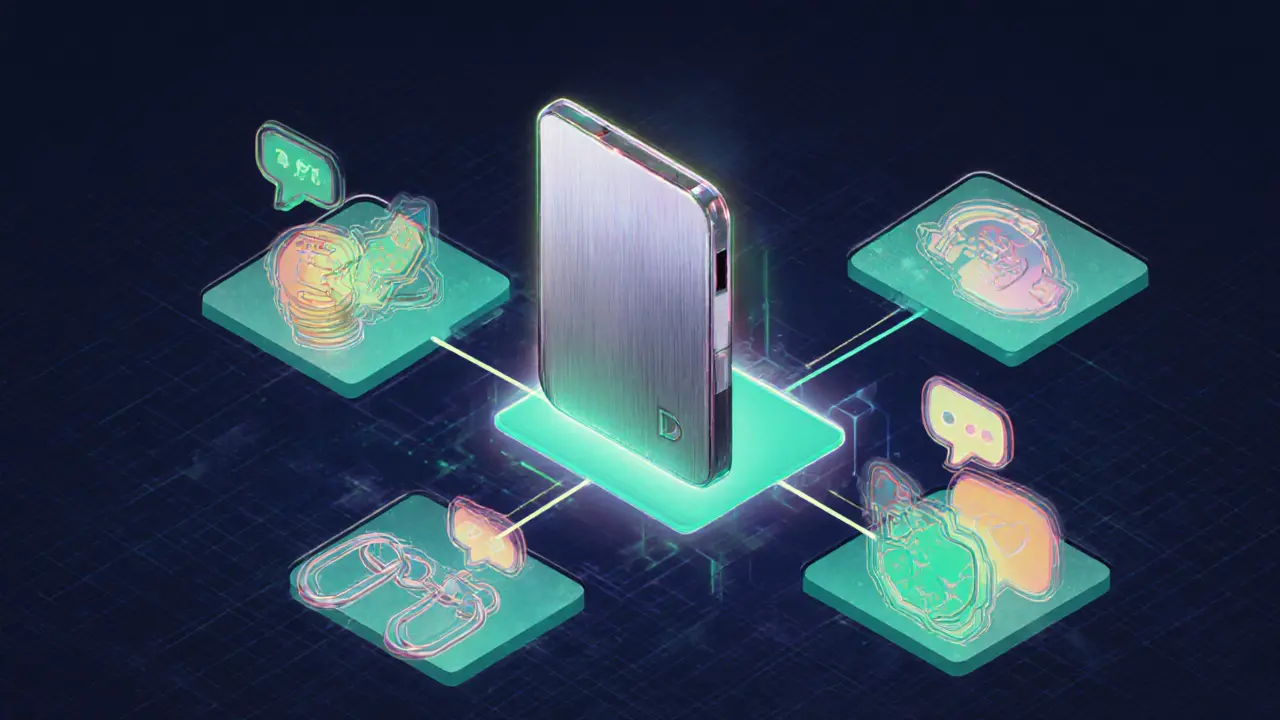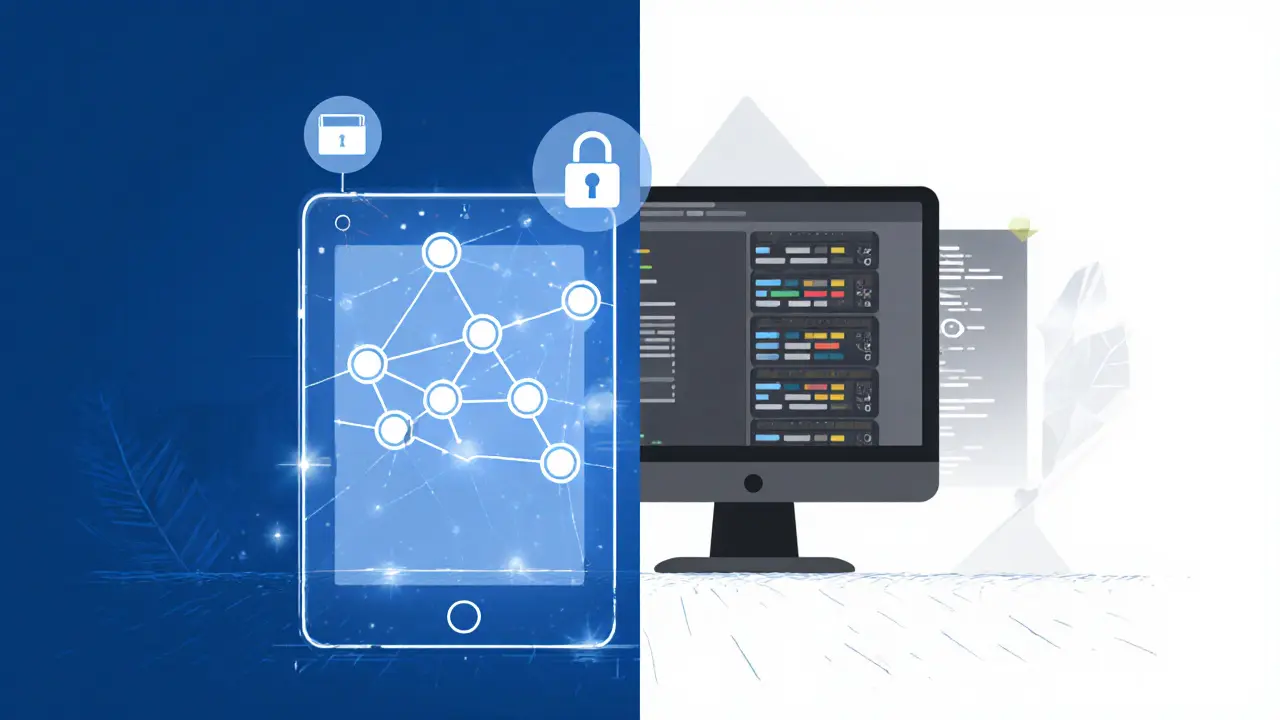dApp Benefits Comparison Tool
This tool compares key features of decentralized applications (dApps) against traditional centralized applications to help you understand their core differences and benefits.
Decentralized (dApp)
Runs on blockchain networks with smart contracts, offering transparency, security, and user control.
Traditional
Operates on centralized servers controlled by companies, often requiring intermediaries.
| Feature | Decentralized (dApp) | Traditional |
|---|---|---|
| Data Ownership | Users control data via wallets | Controlled by service providers |
| Transparency | Public ledger, verifiable records | Proprietary logs, opaque processes |
| Censorship Resistance | Network-wide, no single shutdown point | Subject to regulatory or corporate decisions |
| Cost Structure | Low fees, no server costs | High hosting & maintenance fees |
| Security | Immutable contracts, distributed | Centralized target for attacks |
| Accessibility | Global access with internet connection | Limited by geography and banking systems |
Key Benefits Summary
For Users:
- 1. Full control over personal data and assets
- 2. Transparent transaction records
- 3. Censorship resistance
- 4. Lower transaction costs
- 5. Global accessibility
For Developers:
- 1. Open-source collaboration
- 2. Token-based monetization
- 3. Community ownership
- 4. Interoperability
- 5. Reduced downtime
Use Case Examples
Finance
Decentralized Finance (DeFi) reduces fees by up to 95% and opens markets to the unbanked.
Supply Chain
Immutable tracking provides proof of origin and authenticity for products.
Social Media
Users own content and monetize directly, eliminating data harvesting.
Quick Takeaways
- Decentralization gives you full control over your data and assets.
- Transparency lets anyone verify every transaction on a public ledger.
- Lower costs because middlemen and massive server farms disappear.
- Built‑in censorship resistance keeps services online no matter who tries to shut them down.
- Developers can earn directly from token economies and community support.
What Is a dApp?
When we talk about Decentralized Application (dApp) is a software program that runs on a blockchain network rather than a single central server, we’re looking at a new way to build digital services. Unlike traditional apps that sit on a company’s data center, a dApp lives on a Blockchain (distributed ledger) is a network of computers that all keep a synchronized copy of transaction data. The code that powers the app-usually a Smart Contract (self‑executing contract) is a program stored on the blockchain that runs automatically when predefined conditions are met-executes without any single authority pulling the strings.
Why Users Love dApps
From a user’s perspective, the biggest draw is dApps benefits. Here are the core advantages:
- Full data ownership: Your personal info, assets, and transaction history stay in your wallet, not a corporate database.
- Transparency: Every action is recorded on the Blockchain (public ledger) is visible to anyone, enabling verifiable audit trails. No hidden fees or surprise policy changes.
- Censorship resistance: Because the code lives on a Peer‑to‑Peer Network (P2P network) is a collection of independent nodes that collectively keep the app running, no single government or corporation can shut it down without taking down the entire network.
- Lower transaction costs: By cutting out banks, payment processors, or cloud providers, the fees drop dramatically-often to a few fractions of a cent.
- Global accessibility: All you need is an internet connection and a compatible wallet. Borders, banking restrictions, and even some sanctions become irrelevant.
What Developers Gain
Developers also get a fresh set of incentives that traditional software rarely offers:
- Open‑source collaboration: Most dApps are built on open codebases, inviting contributions from a worldwide community.
- Token‑based monetization: Creators can issue native Token (crypto token) is a digital asset that can represent value, voting rights, or access within the dApp. Revenue streams include transaction fees, token sales, and staking rewards.
- Community ownership: Users often become stakeholders, giving developers direct feedback and financial support through governance votes.
- Interoperability: Because many dApps share the same blockchain standards (ERC‑20, ERC‑721, etc.), they can talk to each other, creating richer ecosystems.
- Reduced downtime: The decentralized infrastructure means the app stays alive even if several nodes go offline.

Technical Advantages Over Centralized Apps
Beyond the business side, the technology itself brings tangible perks:
- Security through immutability: Once a transaction lands on the Blockchain, it cannot be altered or deleted, dramatically lowering hack risk.
- Privacy controls: Users can interact pseudonymously, and data encryption is built into the network layer.
- Scalability via Layer‑2 solutions: Modern dApps leverage rollups and sidechains to handle thousands of transactions per second without sacrificing decentralization.
- High autonomy: No central admin can change the rules overnight; any update must be voted on by token holders or executed through a transparent contract upgrade.
- Resilience: Distributed nodes eliminate a single point of failure, meaning outages are rare and usually localized.
Real‑World Use Cases
Seeing the benefits in action helps solidify the concept. Here are three sectors where dApps are already making waves:
- Financial services: Decentralized finance (DeFi) platforms let users lend, borrow, and trade without banks, cutting fees by up to 95% and opening markets to the unbanked.
- Supply chain management: Companies use dApps to record each step of a product’s journey, giving consumers immutable proof of origin and authenticity.
- Social networking: dApp‑based social platforms let users own their content and monetize directly, eliminating data harvesting by advertisers.
Benefits at a Glance: dApp vs. Traditional App
| Feature | Decentralized (dApp) | Traditional |
|---|---|---|
| Data ownership | User‑controlled wallets | Provider‑controlled servers |
| Transparency | Public ledger, verifiable | Opaque, proprietary logs |
| Censorship resistance | Network‑wide, no single shutdown point | Subject to regulator or corporate bans |
| Cost structure | Low fees, no server costs | High hosting & maintenance fees |
| Security | Immutable contracts, distributed | Centralized target for attacks |
Potential Challenges to Keep in Mind
While the benefits are compelling, it’s honest to acknowledge a few hurdles:
- Scalability limits: Popular blockchains can become congested, leading to higher gas fees during peak times.
- User experience: Managing wallets and private keys can feel technical for newcomers.
- Regulatory uncertainty: Some jurisdictions still grapple with how to classify tokens and dApp services.
Fortunately, ongoing research in Layer‑2 tech, better wallet UX, and clearer legal frameworks are rapidly easing these pains.
Frequently Asked Questions
What exactly makes a dApp different from a regular app?
A dApp runs on a blockchain and uses smart contracts instead of a central server. That means no single company controls the data or the rules, and every transaction is publicly recorded.
Do I need to know how to code to use a dApp?
No. Most dApps provide user‑friendly interfaces similar to web or mobile apps. You only need a compatible wallet to sign transactions.
Are dApps safe if they’re open source?
Open source lets anyone audit the code, which can improve security. However, you should still check that the smart contracts have been audited by reputable firms.
How do dApps reduce costs?
By eliminating intermediaries like banks, cloud providers, or app stores, dApps only pay the modest transaction fees required by the underlying blockchain.
Can a dApp be shut down by a government?
Because the code runs on a distributed network of independent nodes, a government would need to block every node worldwide-a practically impossible task. That’s the core of censorship resistance.

